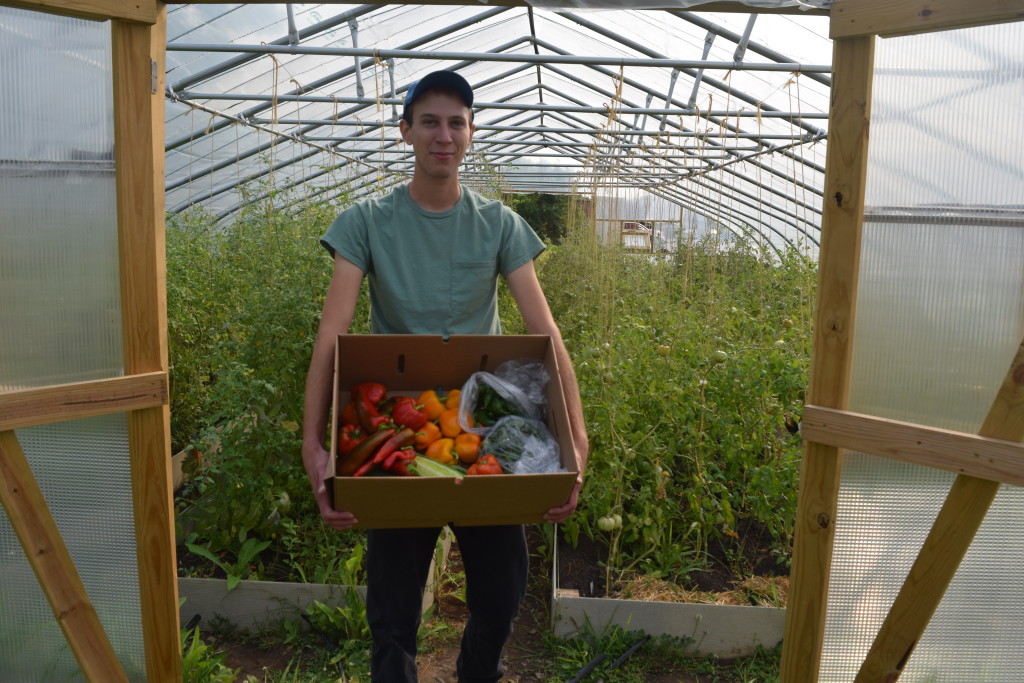
On an August morning, Jared Walhowe, produce specialist for The Food Group Minnesota, commands a 4,800 square-foot “giving garden” on the front lawn of the non-profit’s headquarters in New Hope. A bevy of volunteers — most clad in flannel and caps — hoe, rake, weed, and shovel around him.
The garden’s most striking feature is its high-tunnel greenhouse. Measuring 30 by 48 feet, it’s a steel-frame structure sheathed in polyethylene. Inside, pieces of twine run from soil to roof, encouraging vines to elongate. The polyethylene greenhouse, cheaper to build than a glass one of comparable size, allows The Food Group to extend its growing season and protect crops from pests.
In Hennepin County, Minnesota, 11.5 percent of the population is affected by hunger.
Now in its second summer of cultivation, the giving garden is on track to produce even more fresh produce than the 1,800 pounds it yielded last year. The Food Group hopes that this productive plot inspires corporate campuses and citizens to start their own gardens to feed the hungry.
In Hennepin County, 11.5 percent of the population is affected by hunger. And hunger costs the state of Minnesota $1.6 billion per year in lost productivity, healthcare, hospitalization and more. Yet, the U.S. Department of Agriculture estimates that 31 percent of food in America is wasted. The Food Group is trying to help.
Launched in 1976, the nonprofit supplies food to most food shelves in Hennepin County and to more than 100 food shelves across Minnesota.
Key to its success is its use of multiple food collection techniques. In addition to its giving garden, for instance, The Food Group accepts donations. And it also uses gleaning — an age-old practice of collecting excess fresh food that would otherwise be wasted — from farms, farmer’s markets, orchards and elsewhere. In 2014, the nonprofit gardened, gleaned and received donations in excess of 250,000 pounds of fresh produce. From January to September 2015, that figure was 199,000.
Walhowe, a 6’6″ University of Minnesota-Morris grad, recalls a time when someone asked him if it was okay to donate five tomatoes. “I tell people that there’s no donation too small,” he says.
In addition to using multiple food collection techniques, The Food Group is also unique in its approach to nutrition. “We’re the only food bank, that I know of, with a staff nutritionist,” says Walhowe. That nutritionist is involved in many of the organization’s efforts, including The Food Group’s Fare For Allinitiative — a program which sells discounted groceries at more than 30 sites across the metro. The meat and produce packs sold at these locations are deliberately designed to be nutritionally-balanced. The Food Group also supplies its food shelf partners with repackaged bulk and fresh spices, helping consumers add flavor to their foods without relying on oils, salts, sugars and fats.
Going forward, The Food Group is committed to exploring news ways to provide the hungry with nutritional food. Walhowe grows excited when he discusses two initiatives in particular — partnering with a local food processor to can fresh produce to feed folks during non-growing seasons and expanding gleaning efforts to additional farms.
The Food Group’s staff and volunteers are similarly enthused about the nonprofit’s current and future initiatives.
From the end of a row of ripening peppers, Mickey Foley looks up from under his wide-brimmed sun hat and smiles. “No one should go hungry and everyone should have access to healthy food that’s free of chemicals,” says the 37-year-old freelance writer who volunteers in the giving garden.
Out in the plot, Haley Diem is picking green beans, her cap pulled down against the sun’s glare. She has a bachelor’s in Environmental Studies from Augsburg College and has championed sustainable agriculture her whole career. Right now, she’s an independent contractor for The Food Group’s Fresh Produce Programs. “It’s incredibly satisfying to harvest fresh food directly from the earth and transport it the same day to those who need it,” Diem says. “The work we do is important for local families. And on a larger scale, we are helping to alleviate national health and food security concerns.”
This article was published in September 2015 on Healthy You, Healthy Hennepin — Hennepin County’s online public health magazine — and is available at http://healthyhennepin.org/stories/a-giving-garden
